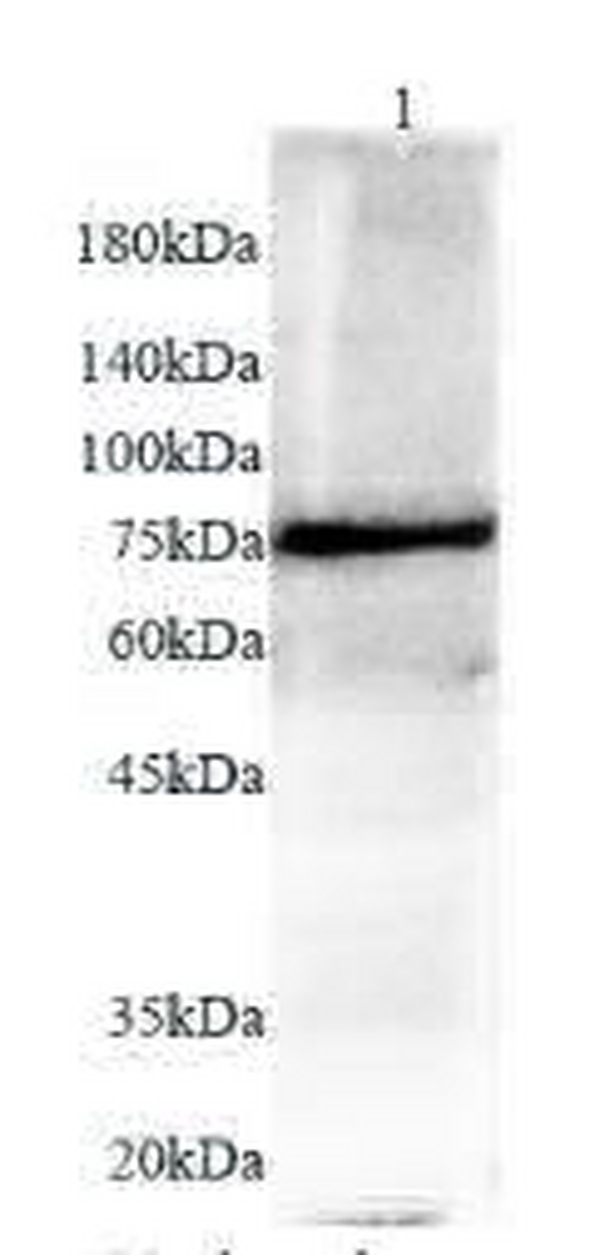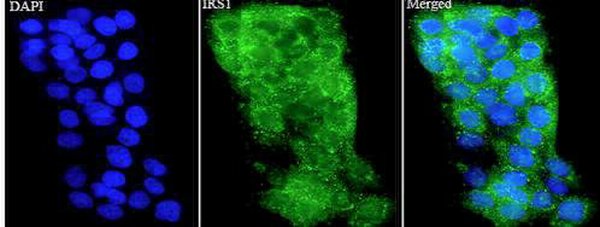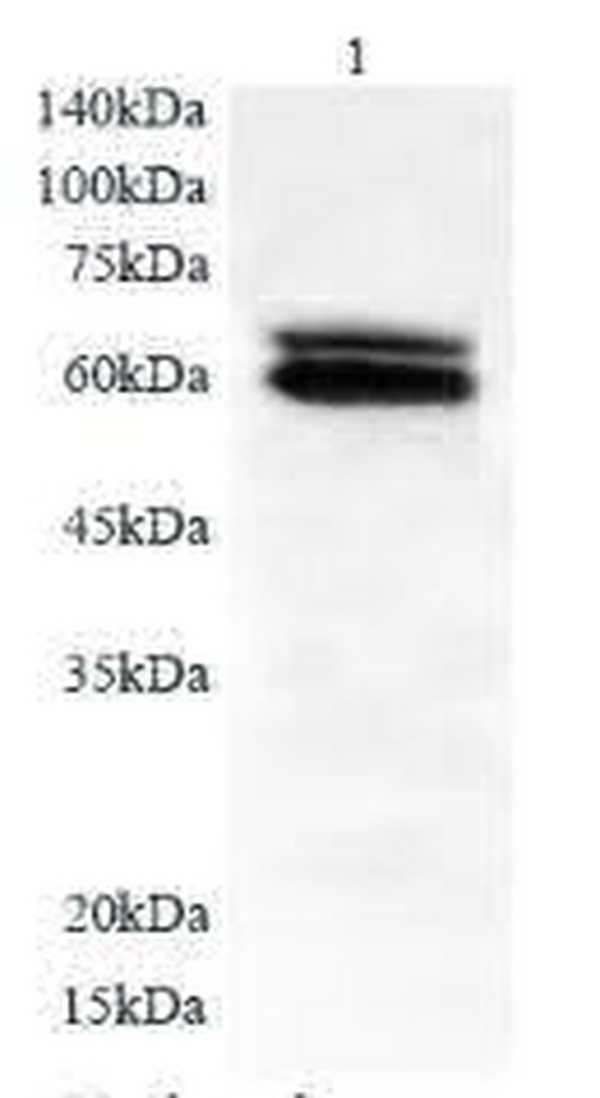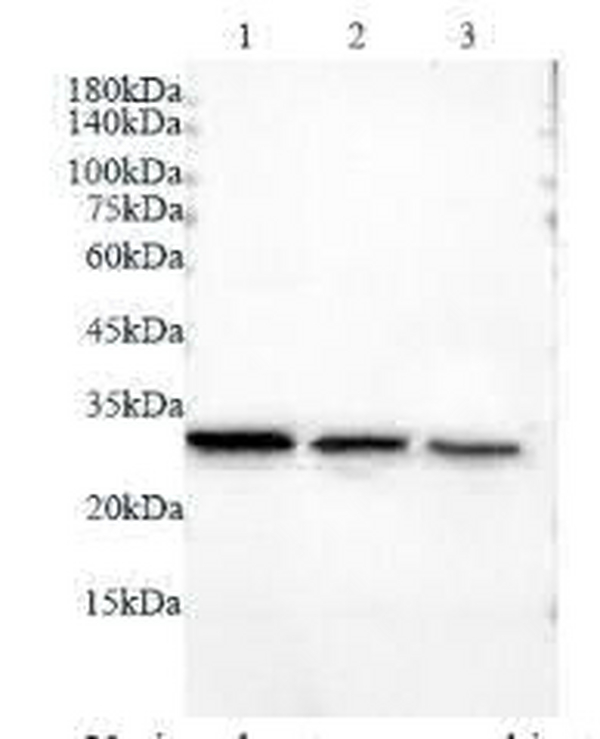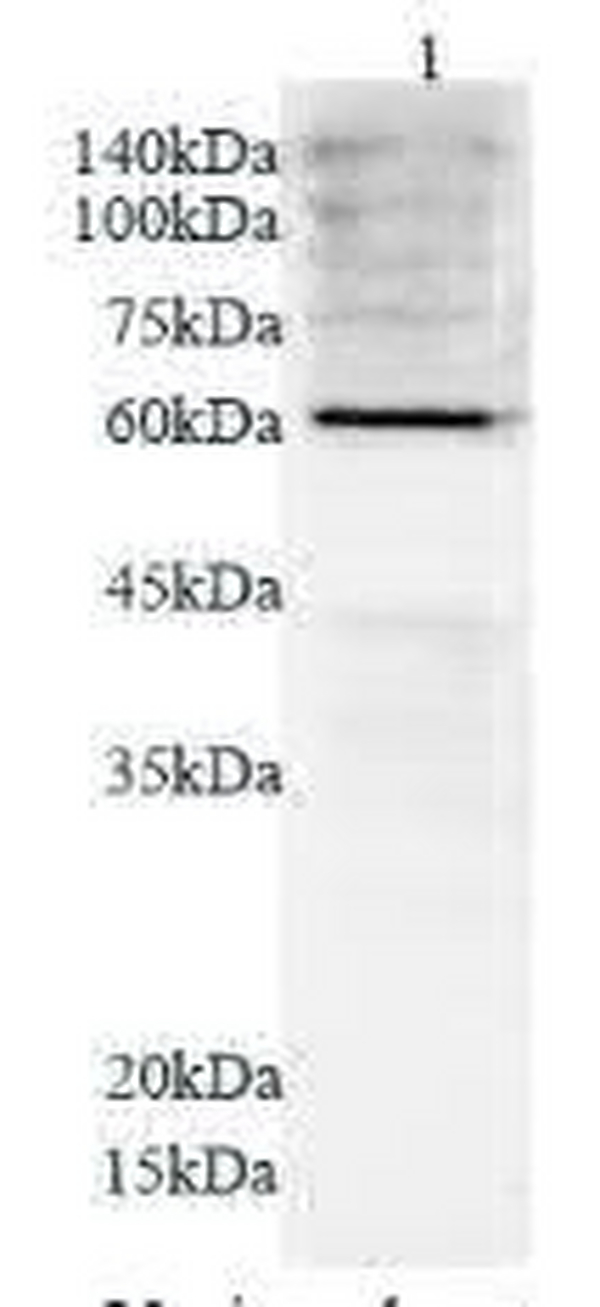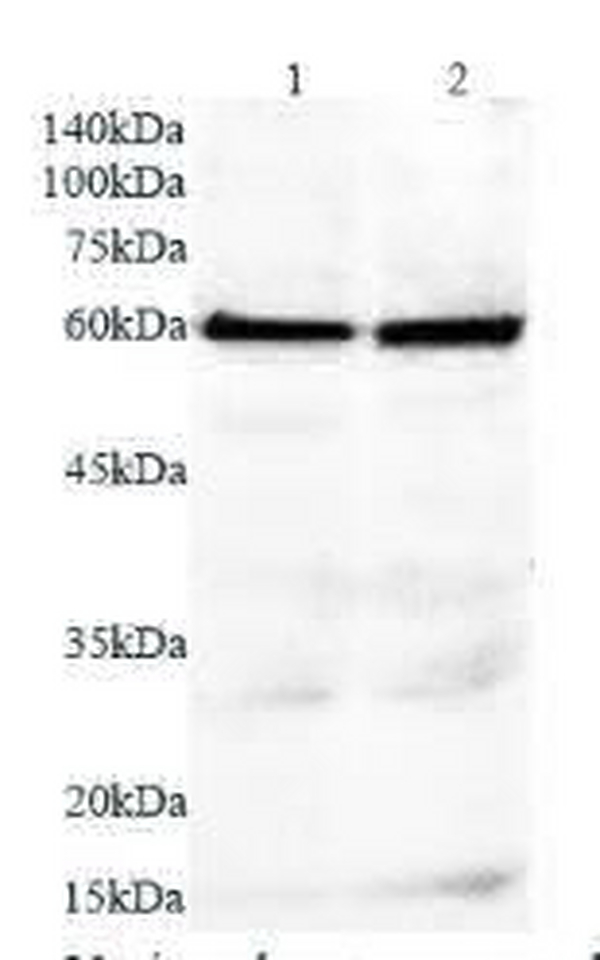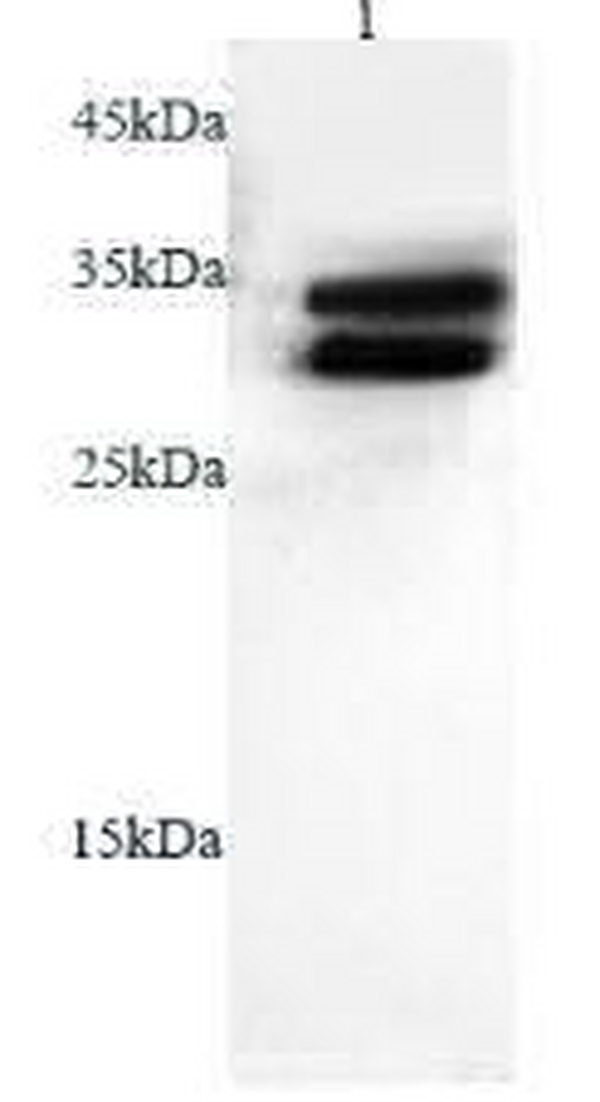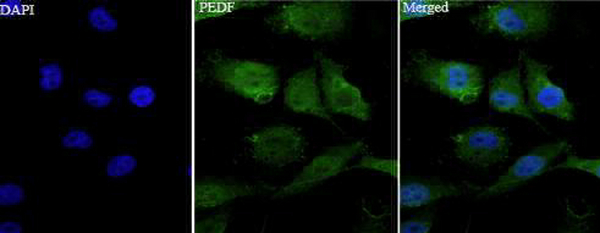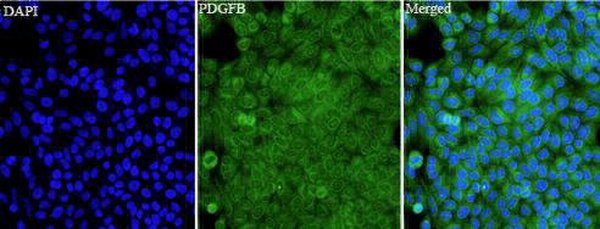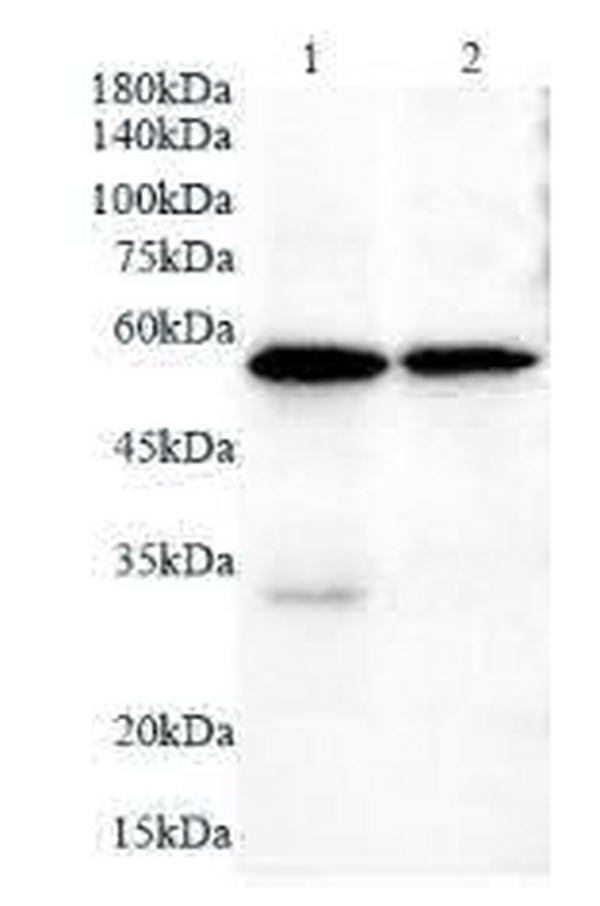QQ:3002763590


客服电话:021-61998208
Anti MX1 polyclonal antibody
MX1抗体
Anti MX1 polyclonal antibodyMx1 (also known as MxA) is a GTPase that belongs to the Mx family of proteins, which are ubiquitous in eukaryotes and involved in the immune response to viral infections. The human Mx1 is localized in the cytoplasm interfering with the translation of viral proteins, whereas the mouse Mx1 accumulates in the nucleus and inhibits the primary transcription of viral RNA. Mx1 expression is induced by treatment with α/β interferon (INF). This antibody can recognize the endogenous Mx1 protein in several tissues like lung and spleen.
Anti IRS1 polyclonal antibody
IRS1抗体
Anti IRS1 polyclonal antibodyInsulin receptor substrate 1 (IRS1) was the first cloned and characterized member of the IRS family which are involved in insulin receptor (IR) and insulin-like growth factor I receptor (IGF-IR) signaling. IRS1 is phosphorylated by insulin receptor tyrosine kinase and is involved in various cellular processes including DNA repair fidelity, transcriptional activity, and cell growth can support tumor development and progression. Mutations in this gene are associated with type II diabetes and susceptibility to insulin resistance. IRS1 has a predicted molecular weight of 132 kDa, however, as a result of its extensive serine phosphorylation it separates on a SDS gel as a band of approximately 160-185 kDa.
Anti SLC39A6 polyclonal antibody
SLC39A6抗体
Anti polyclonal antibodyThe zinc transporter LIV-1 (also known as SLC39A6 or ZIP6) was originally identified as an estrogen-induced gene in breast cancer cells. LIV-1 was also shown to be an effector molecule downstream from soluble growth factors. Elevated LIV-1 expression is reportedly related to cancer progression in various types of cancer, including breast, prostate, pancreatic, cervical and liver cancers. While correlation of LIV-1 and prognosis may vary. LIV 1 has 3 isoforms with MW of 85-100 (glycosylation and phosphorylation), 48 and 32 kDa while migrates as different bands in different lysates in SDS-PAGE.
Anti LDHA polyclonal antibody
LDHA抗体
Anti LDHA polyclonal antibodyLactate dehydrogenase (LDH) is composed of A subunits predominate in skeletal muscle and B subunits are abundantly produced in brain and heart. The LDHA (lactate dehydrogenase A) and COPB1 (coatomer protein complex, subunit beta 1)genes, are involved in energy metabolism and protein transport processes. Both genes might play important roles in muscle development. It has some isoforms with the molecular mass of 27-40 kDa and can form a homotetramer(PMID:11276087). This antibody is specific to LDHA and has no cross reaction to LDHB and LDHC.
Anti CYP3A4 polyclonal antibody
CYP3A4抗体
Anti CYP3A4 polyclonal antibodyCytochrome P450 3A(CYP3A) belongs to the cytochrome P450 family and the enzymes constitute an important detoxification system that contributes to primary metabolism of more than half of all prescribed medications.CYP3A expression determines impairment of drug absorption and efficient systemic clearance in a tissue-specific manner(PMID:17975676).
Anti CHGA polyclonal antibody
CHGA抗体
Anti CHGA polyclonal antibodyChromogranin A is a member of the granin family of neuroendocrine secretory proteins. It is located in secretory vesicles of neurons and endocrine cells. Chromogranin A is the precursor to several functional peptides including vasostatin, pancreastatin, catestatin and parastatin. These peptides negatively modulate the neuroendocrine function of the releasing cell (autocrine) or nearby cells (paracrine). CgA is one of the most used tumor markers in NET's (neuroendocrine tumors) , and elevated CgA concentrations have been demonstrated in serum or plasma of patients with different types of these tumors.
Anti Adiponectin polyclonal antibody
Adiponectin抗体
Anti Adiponectin polyclonal antibodyAdiponectin (AdipoQ), an adipocyte-derived hormone, is one of the most abundant adipokines in the blood circulation. Adiponectin modulates a number of metabolic processes, including improving insulin sensitivity and anti-inflammatory activity. The role of AdipoQ in reproduction is not yet fully understood, but the expression of AdipoQ in reproductive tissues has been observed in various animals and humans, including chicken testis, bovine ovary, and human placenta. Adiponectin exerts its effects by activating a range of different signaling molecules via binding to two transmembrane AdipoQ receptors, AdipoR1 and AdipoR2. AdipoR1 is expressed primarily in the skeletal muscle, whereas AdipoR2 is predominantly expressed in the liver. AdipoQ May play a role in cell growth, angiogenesis and tissue remodeling by binding and sequestering various growth factors.
Anti PEDF polyclonal antibody
PEDF抗体
Anti PEDF polyclonal antibodyPEDF also known as serpin F1 (SERPINF1), is a multifunctional secreted protein that has anti-angiogenic, anti-tumorigenic, and neurotrophic functionsis. It is an approximately 50-kDa secreted protein that is widely expressed, including by osteoblasts and osteoclasts. PEDF is also one of the most abundant secretory products of adipocytes, and circulating concentrations of PEDF correlate positively with body fat mass and insulin resistance. PEDF is a neurotrophic factor involved in neuronal differentiation in retinoblastoma cells. Mutations in this gene were found in individuals with osteogenesis imperfecta, type VI.
Anti PDGFB polyclonal antibody
PDGFB抗体
Anti PDGFB polyclonal antibodyPlatelet-derived growth factor is a potent mitogen for cells of mesenchymal origin. Binding of this growth factor to its affinity receptor elicits a variety of cellular responses. It is released by platelets upon wounding and plays an important role in stimulating adjacent cells to grow and thereby heal the wound. [SUBUNIT] Antiparallel disulfide-linked dimer of nonidentical (A and B) chains. Homodimers of A and B chains are implicated in transformation processes. A-A and B-B, as well as A-B, dimers can bind to the PDGF receptor. Belongs to the PDGF/VEGF growth factor family.
Anti CRTC polyclonal antibody
CRTC抗体
Anti CRTC polyclonal antibodyCALR,also named as grp60, ERp60, HACBP, CRP55, CRTC and Calregulin, belongs to the calreticulin family. It is a molecular calcium-binding chaperone promoting folding, oligomeric assembly and quality control in the ER via the calreticulin/calnexin cycle. CALR is a ER marker. It interacts transiently with almost all of the monoglucosylated glycoproteins that are synthesized in the ER. CALR interacts with the DNA-binding domain of NR3C1 and mediates its nuclear export. The MW of CALR migrates aberrantly at 55 kDa by SDS-PAGE. Some study provided that it's a new possibility for CRT-mediated tumor immune prevention and treatment.
最新动态
-
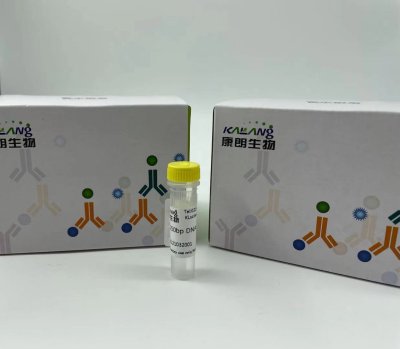
Anti-GNGT1 KL20092-001(50ul)
2021-10-11 -

Anti-GNGT1 antibody(50ul) KL20093-001
2021-10-11 -
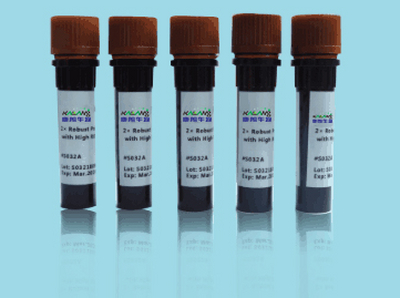
MUC5AC (PT2058) mouse Monoclonal Antibody
2021-01-06 -

mOrange mouse Monoclonal Antibody(Mix)
2021-01-05
热门标签
- Histone H3 rabbit Polyclonal Antibody Histone H3抗体
- EGFR rabbit Polyclonal Antibody EGFR抗体
- Cy3 Conjugated
- AbFluor™ 555 Conjugated
- AbFluor™ 680 Conjugated
- AbFluor™ 350 Conjugated
- AbFluor™ 647 Conjugated
- AbFluor™ 594 Conjugated
- AbFluor™ 405 Conjugated
- Cy5 Conjugated
- AbFluor™ 488 Conjugated
- Cyclophilin B抗体 Cyclophilin B Monoclonal Antibody(2B10)
- COX IV抗体 COX IV Monoclonal Antibody(6C8)
- PCNA抗体 PCNA Monoclonal Antibody(12D10)
- FAK rabbit Polyclonal Antibody FAK抗体
邮箱:3002763590@qq.com
电话:021-61998208

扫码关注微信公众号



